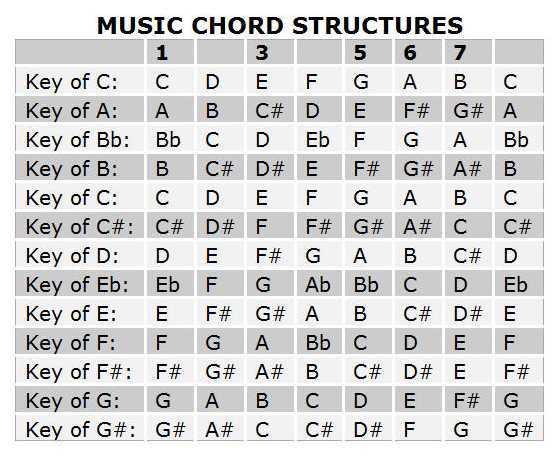Major triad chords for Steel guitar
Triads are chords containing three notes: the root, third and fifth. For example: C major consists of the notes C, E and G.
Minor triad chords for Steel guitar
Triads are chords containing three notes: the root, third and fifth. Minor triads are similar to major triads except for a minor third. For example: C minor consists of the notes C, Eb and G.
6th chords for Steel guitar
The 6th chords are identical to the major triad, but with an additional sixth. For example: C6 consists of the notes C, E, G and A.
Augmented chords for Steel guitar
The augmented chord is similar to a major triad, but with a raised fifth. Thus, the augmented chord is made up of two major thirds stacked on top of one another. For example: C major consists of the notes C, E and G#.
m7b5 chords for Steel guitar
The m7b5 chord is similar to a minor seventh, but with a lowered fifth. For example: Cm7b5 consists of the notes C, Eb, Gb and Bb.
7th chords for Steel guitar
The 7th chords are chords made up of a major triad plus a minor seventh, also known as dominant seventh chords. For example: C7 consists of the notes C, E, G and Bb.
9th chords for Steel guitar
The 9th chords are chords made up of a major triad plus a seventh and a ninth. A full 9th chord consists of five notes, but sometimes the fifth or third are left out. For example: C9 consists of the notes C, E, G, Bb and D.
Minor 7th chords for Steel guitar
The minor seventh chord is a minor triad plus a minor seventh. For example: Cm7 consists of the notes C, Eb, G and Bb.
7#5 chords for Steel guitar
The 7#5 chord is similar to the regular seventh chord, but with a raised fifth. For example: C7#5 consists of the notes C, E, G# and Bb.
7#9 chords for Steel guitar
The 7#9 chord is similar to the seventh chord, but with an additional raised ninth. The raised ninth is identical to the minor third, which means that the 7#9 contains both the major and the minor third. For example: C7#9 consists of the notes C, E, G, Bb and D#.
m9 chords for Steel guitarThe minor ninth chord is a minor triad plus a seventh and a ninth. For example: Cm9 consists of the notes C, Eb, G, Bb and D.
maj7 chords for Steel guitar
The maj7 chord is a major triad plus a major seventh (maj7 = major seventh). For example: Cmaj7 consists of the notes C, E, G and B.
add9 chords for Steel guitar
The add9 chord is a major triad with an additional ninth. Unlike the regular 9th chord, the add9 has no seventh. For example: Cadd9 consists of the notes C, E, G and D.
13th chords for Steel guitar
A full 13th chord is made up of seven notes. That is a major triad plus a seventh, ninth, eleventh and the 13th. Since this is impossible to play on a six-string steel guitar, the fifth and the third are often left out (and sometimes even the root). For example: A C13th consists of the notes C, E, G, Bb, D, F and A.
Diminished 7th chords for Steel guitar
The dim7 (diminished seventh) is made up of a diminished triad (i.e. a minor triad with a lowered fifth) and a diminished seventh interval. The diminished seventh interval is a minor seventh that has been lowered a half note (identical to a straightforward sixth). In other words, the diminished seventh is constructed by putting four minor thirds on top of each other. For example: Cdim7 consists of the notes C, Eb, Gb and Bbb (In this example, the diminished seventh interval is written as "Bbb", not as "A").
Suspended (sus) chords for Steel guitar
Sus4 chords have no third, which is "suspended" (sus = suspended) and replaced by a fourth. A variant of the sus-chord is the sus2, where the third is replaced with a second. The sus-chords are neither major nor minor chords. For example: Csus4 consists of the notes C, F and G.
Chord Structures
Note: Once you learn and understand how musical chords are constructed, you'll be able to pick up ANY musical instrument and be playing it in a few minutes. I can actually hear a major or minor chord and identify them. Russian music uses a lot of minor chords. I can tell you if a chord is a 7th, or dominant 7th. And of course, a steel guitar player can readily recognize that Hawaiian sounding C6th chord, which is exactly what a standard ukulele is tuned to. The ukulele is tuned, from the 4th (bottom) to the 1st string (top)... G, C, E, A (or as I like to remember, “God Created Every Animal”). This note pattern will give you the famous melody, “My Dog Has Flees!”
A major scale is composed of the 1st, 3rd and 5th notes of any scale. If you flat the third note, you have a minor chord. If you add the 6th note to a major chord, you have a 6th (or relative A minor). There are a lot of helpful teaching aids online to help you understand music theory. You don't need to become Beethoven or Mozart to excel as a musician. Jerry Byrd couldn't read music, although he recommended for musicians to do so if given the opportunity. It can only make you a better steel guitarist. Notice below for the key of C (first row) that the 1st, 3rd and 5th notes (C, E, G) form a C major chord. If you add an A, the 6th note, you now have a C6th chord. Cool huh?
This reference chart is helpful in that you can quickly identify what notes compose a specific chord, either to construct a necessary chord or name a chord that you're already playing...





